- Introduction
- Are Leaders Leading or Managing?
- Are Managers Managing and Leading?
- Critical analysis of the structure of the organization
- Critical analysis of the roles in the organization
- What Thorntons does well regarding leadership and management requirements
- What is Thorntons succeeding in?
- Potential areas of improvement to meet the need for leadership and management
- Conclusion
- Works Cited
Introduction
- Is Thorntons delivering requirements of leadership, management or both?
- Elements of good practice and areas of improvement.
- There is a close relationship between leadership and management.
- Leaders set the direction and bear the vision, then go on to motivate people to work towards realizing the vision.
- Managers plan, organize, and control or resolve problems that arise on a daily basis in an organization (Christy 83).
This paper seeks to provide a critical analysis of whether Thorntons is delivering requirements of leadership, management or both. It identifies elements of good practice and areas of improvement. The presentations builds upon a case study of Thorntons, a British chocolate maker specializing in gifts.
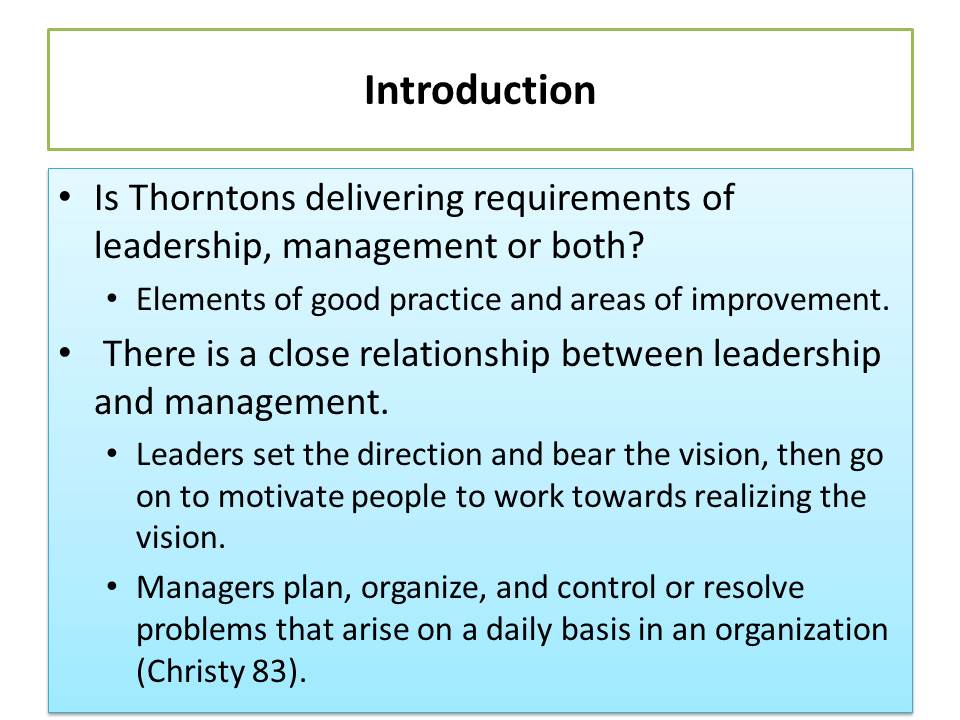
Are Leaders Leading or Managing?
A leader must consistently monitor the interactive system network within a corporate environment for any changes:
- Changes to look out for are those that alter the existing relationships within the network (Stringham 20).
At Thorntons, the CEO is leading:
- He has put up a vision for the company’s recovery program
- He ensures that all employees understand what can happen to their jobs.
- Workers also know what is required for Thorntons to achieve its recovery goals.
Firms can pursue an operations strategy or a development strategy:
- Operations strategy- requires managers;
- Development strategy- requires leaders.
Irrespective of whether a leader is leading or managing, he or she must consistently monitor the interactive system network in a corporate environment for any changes. In this case, changes to look out for are those that alter the existing relationships in the network (Stringham 20). At Thorntons, the CEO does not involve himself with the actual running of stores. Therefore, the CEO does not demonstrate management skills. Instead, he appears inspirational because of his honesty and engagement style; he focuses on building an appropriate organization culture.
In operations strategy, a firm concentrates on the current resources and capabilities; therefore, it needs managers more than leaders. In the case of development strategy, the firm concentrates on future goals and objectives; therefore, it requires more leadership than management skills (Stringham 28).
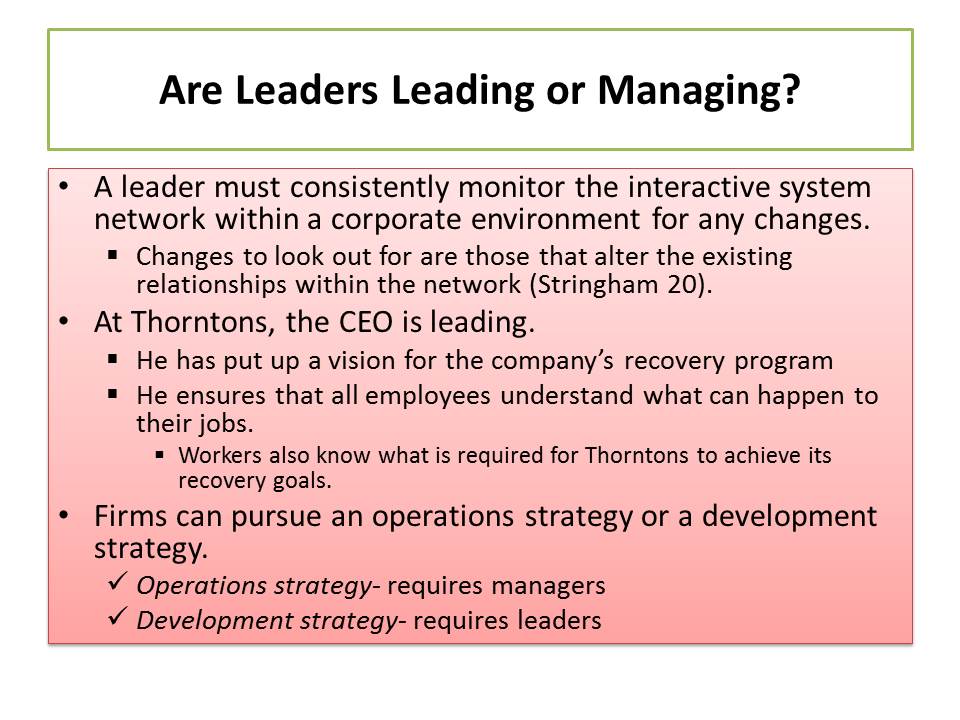
Are Managers Managing and Leading?
At Thorntons, managers appear to lead more than they manage:
- the company does not have adequate management resources to ensure that it exploits the workers’ goodwill.
There is minimal evidence to show managers being concerned with actual performance:
- Thorntons’ focus is on excellence, empowering people, and being creative.
With limited management opportunities, the firm is capable of chocking its growth. Leaders need to delegate enough roles to managers, such that there is a clear separation of strategic formulations and implementation of the formulated strategies. At Thorntons, the top leadership makes almost all decisions concerning growth and the daily operations of the company, leaving the managers with limited opportunities to exercise control.
After the restructuring, managers now have to handle people relationships consistently. They have to get out of their offices, inspect work, and consult with employees. Although the managers are doing supervisory work, which requires management skills, they are also relying more on people skills, relationship management concepts, and leadership traits.
Nevertheless, the company succeeds in managing things in the period of review, which is a clear indication that despite the management employees being oriented to leadership, some management tasks actually prevail. For example, the company adopts a vision and follows clear objectives, such as reducing the number of stores. It also has tactical plans, such as the use of delicate piping techniques to decorate chocolates. Managers have to coordinate the process that rely on both machines and workers to ensure there is smooth workflow.
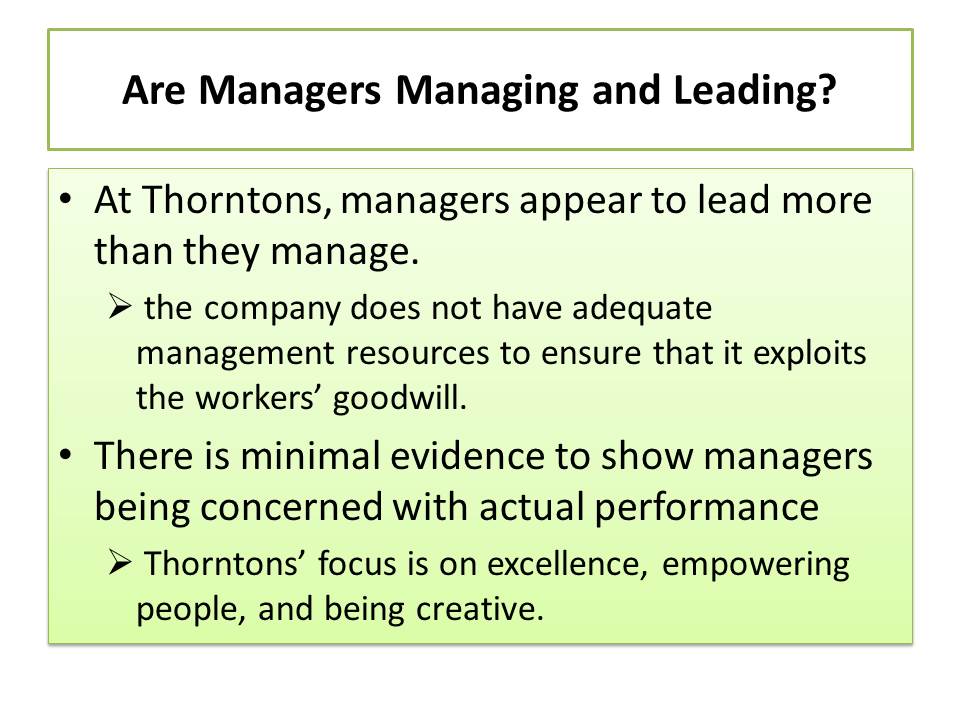
Critical analysis of the structure of the organization
An organizational structure serves as the business’ skeleton:
- It holds everything together to ensure that the business functions as it should.
With a poor structure:
- the same fix serves repeated problems;
- over time employees and management staffs display a tendency to settle for less.
A robust firm structure in the way it facilitates leadership and management practices can prevent the above problems (Stringham 23).
Thorntons has a fairly good structure:
- It minimizes operational glitches, but it does not eliminate them all.
The structure of any organization can be poor when too many people take part in decision making at all stages, the workers do not know the prevailing priorities, there are no spare capacities for leaders to take on new tasks, and employees duplicate work and keep coming up with new ways of doing the existing work. The importance of an organizational structure is to make the organization effective. Thus, key elements of a strong organization are the presence of a capable decision making structure, the right people, and work processes and systems that promote a culture of high job commitment and achievement.
Employees rely on the available organisational structures to facilitate division of labour, operation efficiency, and resolution of conflicts. Good structures have few glitches, allowing smooth execution of business functions.
A visible chain of command shows the strength of the organisational structure:
- top leadership positions,
- middle-level management,
- specific division heads.
Managers know what skills are required for specific tasks (Lussier and Achu 56).
Thorntons has a manufacturing division that relies on machine-aided work:
- It employs technical managers and line workers.
- It functions through specific and tightly controlled procedures that provide no room for error.
Even though workers are decorators who are expected to maintain creativity, they handle predetermined designs and only contribute to the handcrafting part of the creative value addition.
Manufacturing and financial organizations have many repetitive tasks that require proper management structures to control the flow of work. On the other hand, organizations operating in creative realms, such as entertainment and advertising companies, may focus more on innovation. Therefore, they require structures that promote trial and error learning, knowledge sharing, and a high-risk appetite.
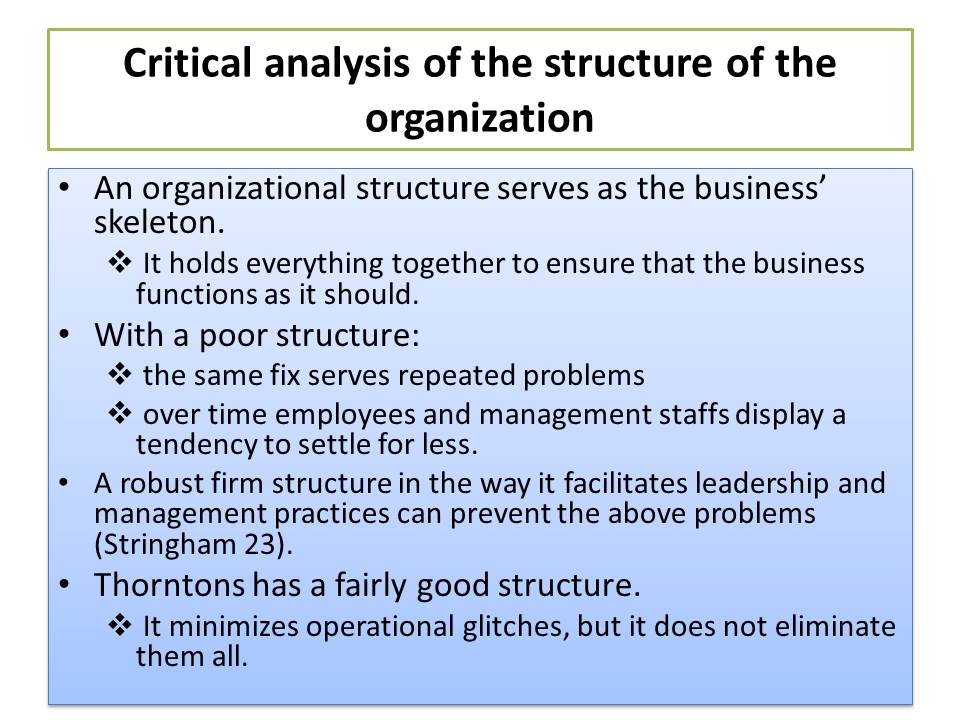
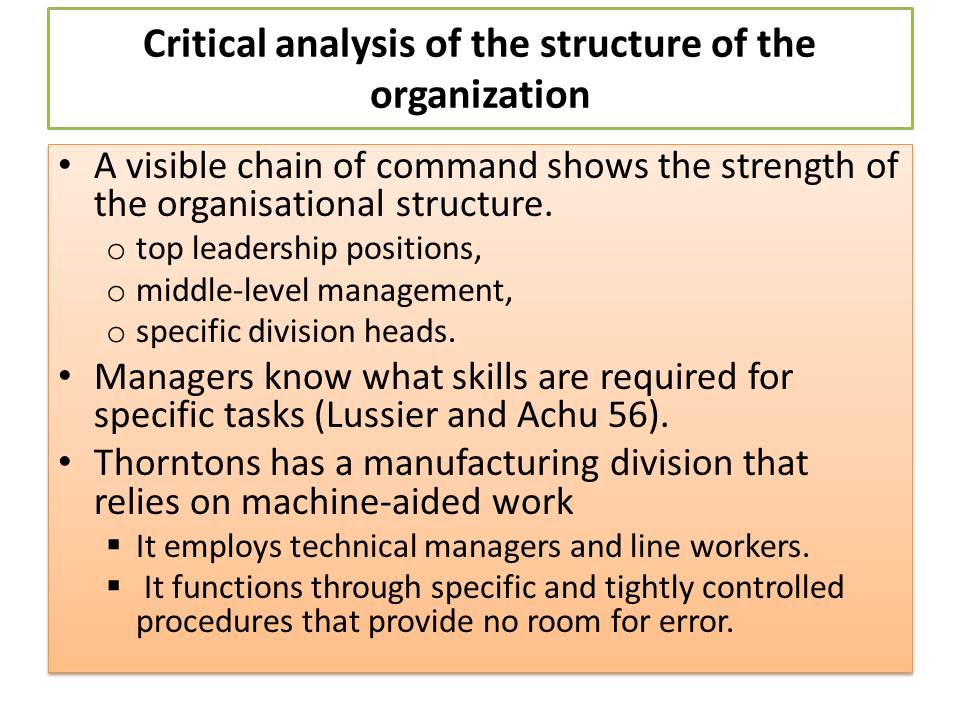
Critical analysis of the roles in the organization
The chief executive officer (CEO) at Thorntons is Jonathan Harts. He:
- leads the executive team in achieving the goals set out in the transformation plan.
- communicates the structure of the executive plan to all the senior managers.
- holds the responsibility of ensuring that the Own Stores strategy achieves success.
Senior managers:
- Handle brand and customer marketing.
- Retail trading and business development:
- there are specific store managers for every store
- there are department managers for finance, sales, and other business units in Thorntons.
The role of each manager is to ensure that his or her respective division contributes to the growth in commercial channels sales of the company. Division heads have to coordinate marketing, sales, and business development tasks to provide store managers will simple and easy to follow routines, benchmarks, and tactics to implement to ensure that stores achieve the desired sales goals (Gold, Thorpe and Mumford 244).
Financial managers have to coordinate the finances of the company, propose saving and expenditure areas, and give feedback to other managers and top leaders concerning ongoing company performance and the financial goals of the company.
Financial managers and other management staffs have to propose cuts or expenditure realignments that store or other lower level managers need to implement. They also monitor government policy on taxation and other business related legislation to help them advise or effect changes in the organization.
Store management staffs need to govern the conduct of the employees to ensure that customer care tasks are handled well. Store managers must respond to employee and customer feedback and complaints and offer solutions or seek interventions from the respective middle-level managers (Gold, Thorpe and Mumford 244).
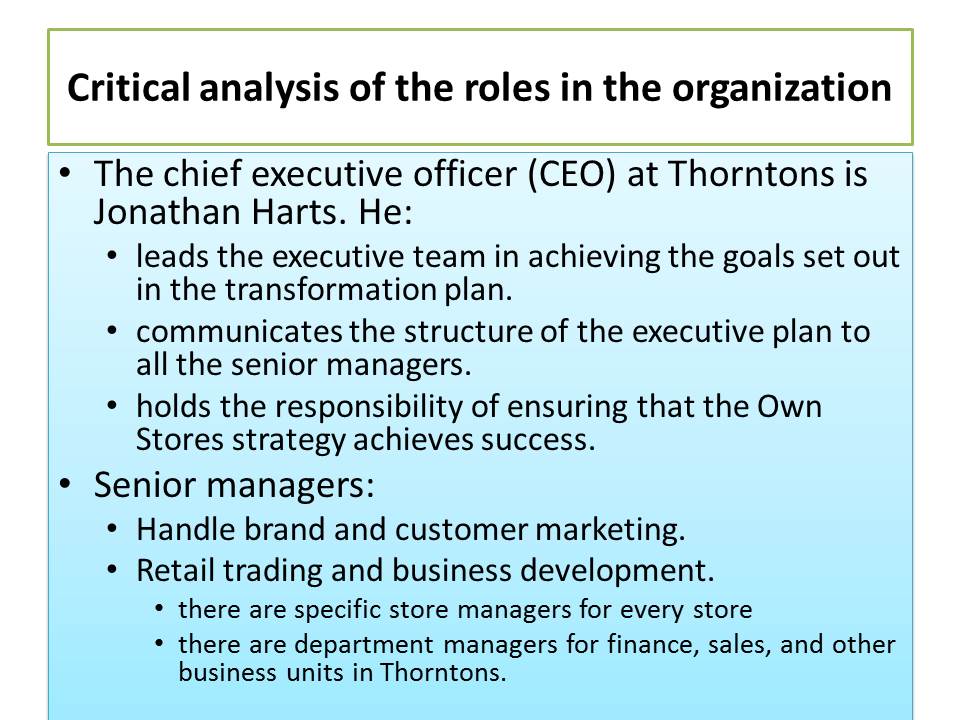
What Thorntons does well regarding leadership and management requirements
Thorntons has a strategy for growth and communication of the parameters.
Thorntons’ strategy is measurable:
- it has defined performance indicators that allow leaders to evaluate its success in different periods.
- it is an indication of good leadership that is task-oriented (Yukl 123-131).
There are few instances of performance measurement at the company:
- return on investment, corporate social indicators, and sales’ growth indicate whether the company is achieving its operations excellence goal.
At lower levels of organization, position leadership leads to individual and team level outcomes. On the other hand, the work of the middle-level managers affects individuals, teams, and business units. Meanwhile, the executive leader affects the outcome of firm-level strategies. The important point to note is that at all levels of the organization, leadership plays a critical role in ensuring preferred outcomes become realities (Yukl 123-131).
At Thorntons, the company had to make optimal use of its prime located stores to increase sales. It also had to leverage on its traditional gift producing technology to provide a handcrafted product, as much as there was the need to use automated machines to improve productivity.
Thorntons identified employees as critical resources for achieving the firm’s goals. It went on to manage their involvement in strategy implementation. With specific roles for brand managers, product development managers and technical managers, there was adequate coordination of activities to overcome most of the obstacles that arose out of the implantation program for the recovery strategy. Doing things rightly require soft skills to facilitate a good structure that allows specific people to fulfil work-specific roles within their departments (Christy 86).
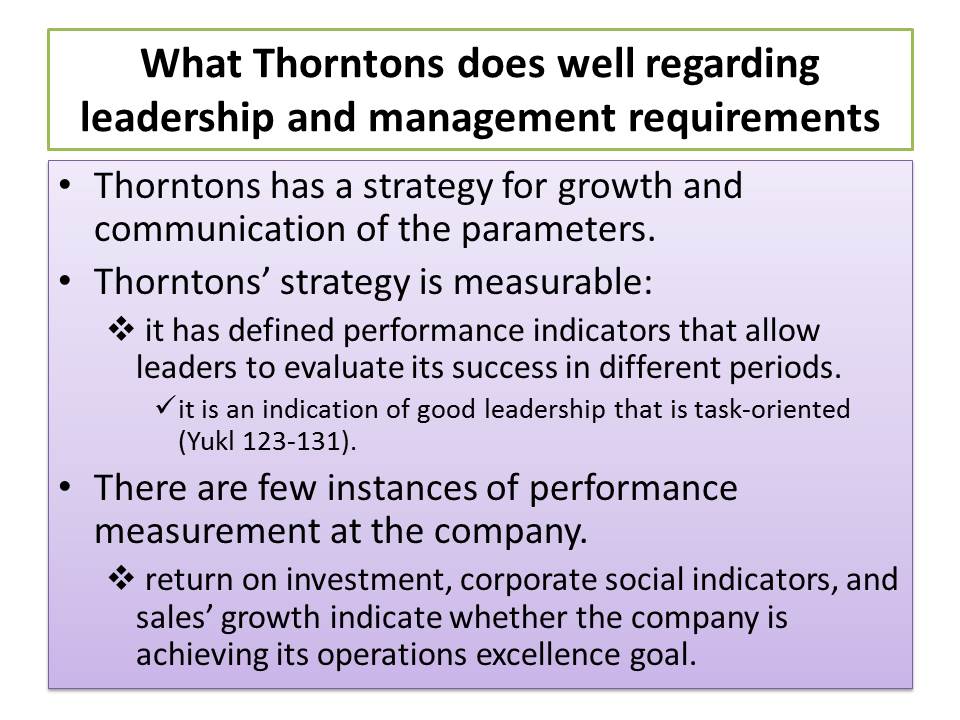
What is Thorntons succeeding in?
Leadership entails providing direction, facilitating change, and working with people (Christy 85):
- All these elements are present in the Thorntons case study.
Thorntons has a good grasp of these elements:
- It achieves the required cooperation through adequate relationship management.
Elements that mostly relate to management:
- using resources.
- achieving results.
- managing personal skills.
According to Christy (85), leadership entails providing direction, facilitating change and working with people. All these elements are present in the Thorntons case study.
Moreover, the organization demonstrates a good grasp of the elements, thereby managing to highlight the importance of employee commitment to organisational change and achieving the required cooperation through adequate relationship management.
On the other hand, Christy (85) provides other elements that mostly relate to management. They include using resources and achieving results, as well as managing self and personal skills.
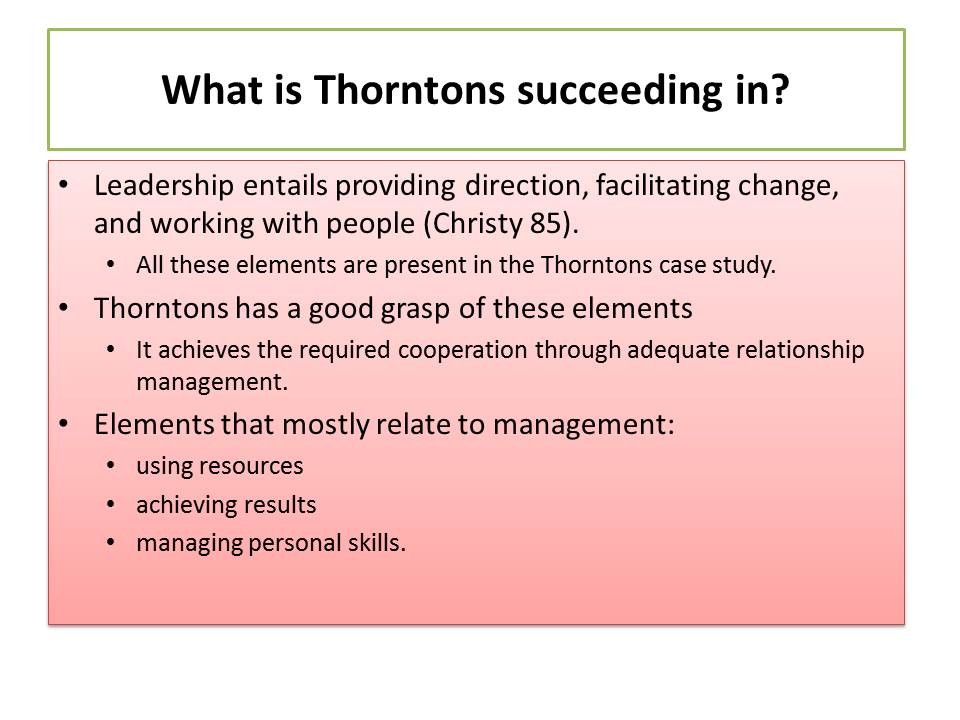
Potential areas of improvement to meet the need for leadership and management
Thorntons’ CEO believed that employees expressed adequate commitment:
- Therefore, there was no need for incentives to increase productivity.
The company’s management should lean towards the Y side of the theory X and Y:
- managers should encourage participation and use transformative leadership styles (Lussier and Achu 41).
It calls for the use of examples and taking initiative so that workers can follow the examples provided.
Leadership theories and frameworks help to analyse leadership and recommend areas that need improvement, according to a specific situation. On the contrary, management theories help in increasing organizational productivity.
Most prominent leadership frameworks either follow the Michigan studies or the Ohio studies, while the major management theories are the contingency theory, chaos theory, system theory, and theory X and Y. An organization can implement any of the above theories in situ or as combinations to achieve desired results.
Therefore, while the top leadership communicates goals and targets to line managers, it can also participate in the achievement of the goal through demonstrations, open days, and other flat organization strategies and use the experience as learning opportunities. In doing so, it will reduce the information feedback loop drastically. Consequently, matching leadership strategies and organizational needs will be easier (Hughes 128).
Resultantly, traditional management practices can exist together with the modern ones that encourage bi-directional communication at all levels of the organization (Borkowski 80).
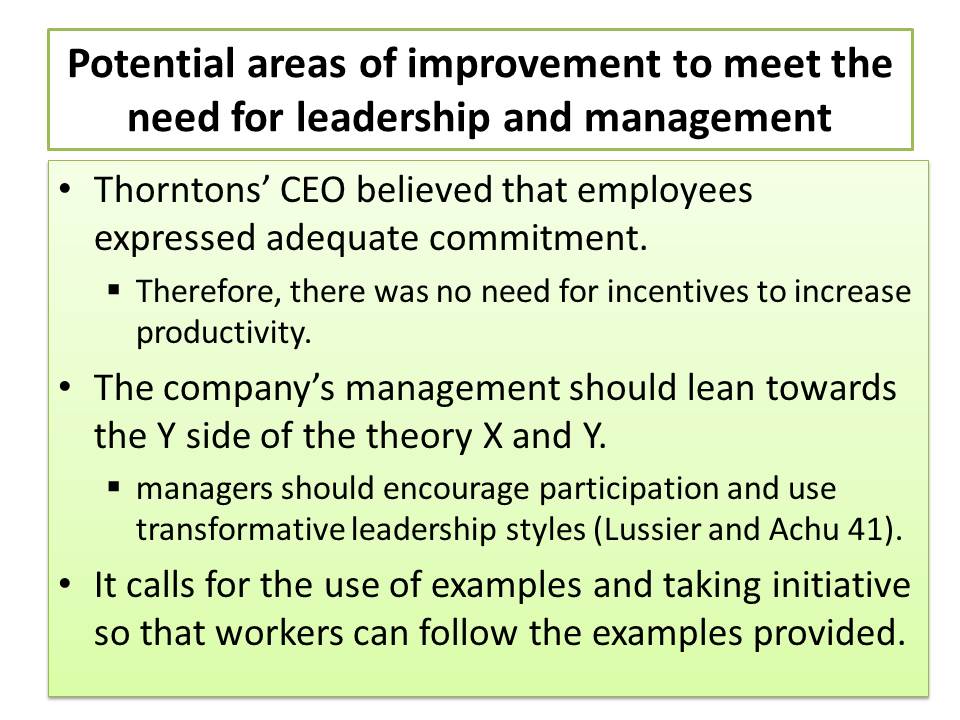
Conclusion
- The new strategy does not appeal to individual differences, such as preferred working styles and personal capabilities.
- It also does little to promote organization learning.
- Therefore, Thorntons would work best with a combination of a flat and a hierarchical organizational structure.
Although the new strategy is positioned well to help in the recovery of Thorntons, it does not appeal to individual difference in workers, such as preferred working styles and personal capabilities.
It also does little to promote organization learning, which can help the firm prevent its past mistakes and be innovative in its approach to handling new challenges.
In this regard, and following a systems theory approach, the firm would work be with a combination of a flat and a hierarchical organizational structure (Borkowski 80).
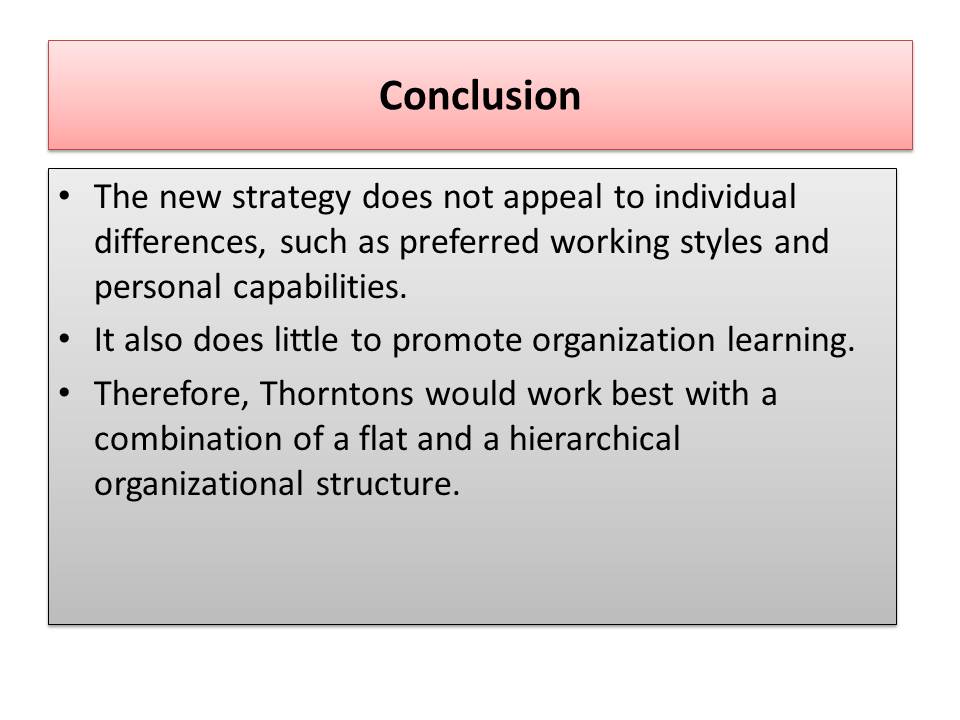
Works Cited
Borkowski, Nancy. Organizational Behavior, Theory, and Design in Health Care. London: Jones and Bartlett Publishers, LLC, 2009. Print.
Christy, Gill. “Leadership.” Rayner, Charlotte and Derek Adam-Smith. Managing and Leading People. Eds. London: CIPD, 2009. 81-100. Print.
Gold, Jeffrey, Richard Thorpe and Alan Mumford. Gower Handbook of Leadership and Management Development. 5th ed. Surrey: Gower Publishing Limited, 2010. Print.
Hughes, Mark. Change Management: A Critical Perspective. London: Chartered Institute of Personal and Development, 2006. Print.
Lussier, Robert N. and Christopher F. Achu. Leadership: Theory, Application & Skill Develoment. Mason, OH: South-Western Cengage Learning, 2010. Print.
Stringham, Shand. Strategic Leadership and Strategic Management: Leading and Managing Change. Bloomington, IN: iUniverse, 2012. Print.
Yukl, A. Gary. Leadership in Organizations. 7th ed. New Jersey: Pearson Prentice Hall, 2007. Print.